If you are looking for chickens to keep in your backyard, there are specific characteristics you want in a breed: hardiness, a calm disposition, good egg-laying capabilities, and the ability to live in a small space. A breed we recommend is the Sussex, which comes in several color variations. We will focus on the Light.
Although this breed is more popular in England, Canada, and Australia than in the US, we suggest you try getting hold of them, as they are superb birds. They are hardy, not prone to disease, friendly, docile, and curious. They are moderate egg layers and lay through the winter.
Light Sussex Chickens Overview
- Origin: English counties of Sussex, Kent, and Surrey. Descended from old British and Roman chickens, improved in Victorian times by crossbreeding with Cochins, Brahmas, and Dorkings
- Colors: speckled, light, brown, buff, red, silver, white, and coronation
- Size: medium to large (hens approximately 7 pounds; roosters about 9 pounds).
- Bantam size: small (hens approximately 2 pounds; roosters around 4 pounds)
- Lifespan: 8 years or more
- Health Issues: minimal, but watch for parasites
- Temperament: friendly, curious, and docile. Prone to being bullied by more aggressive breeds
- Ideal coop space: 4 square feet per chicken. Increase to 6 square feet if housing with more aggressive breeds
- Purpose: dual-purpose (meat and eggs). Also popular for exhibition due to their beautiful coloration
- Egg production per year: 180 to 210. Layer strains (generally light) may produce as many as 250. Exhibition strains tend to lay poorly
- Egg size: large (2 ounces)
- Egg color: cream to pinkish-brown
Why You Should Consider Getting Light Sussex Chickens
Sussex chickens are excellent for novices and families and would also be ideal for a 4-H agricultural project to teach children life skills through hands-on learning.
They are hardy in various conditions, provided you supply their basic needs for food, water, and safe shelter; they don’t have any requirements for special treatment. As long as you practice basic biosecurity, they are not prone to disease.
They are good foragers and, therefore, thrifty hens so you can keep your feed bill to a minimum.
They lay reasonably well and have beautiful plumage. The all-white coloration of Light Sussex chickens is striking and stands out in a mixed flock.
They have gentle, docile, and quirky natures, and enjoy the company of their people, often joining in the conversation. They can be picked up and cuddled, making them great pets for kids.
Origins Of The Sussex Chicken Breed
The origins of Sussex chickens lie thousands of years ago, as the Romans found chickens in southeastern Britain when they invaded in 43 AD. Although these birds are the ancestors of today’s Sussex chickens, they would have looked quite different, and their original colors are thought to have been speckled and possibly brown.
The Romans may have also brought chickens with them and crossed them to the local chickens, but it was only in Victorian times that the modern breed took shape. Over the long reign of Queen Victoria, various enthusiasms gripped Britain, and from about 1845 to 1855, hen fever swept that nation and the US.
The Brahma and Cochin breeds were a particular focus of the hen fever, and fanciers bred these 2 breeds with the Sussex to the robust, well-proportioned birds we are now familiar with. Another breed that contributed to the modern light Sussex was the silver-gray Dorking, a breed from the English county of Surrey also thought to date to Roman times.
In 1845, the first poultry show was held in London. Birds were exhibited that were referred to as “Old Sussex or Kentish fowl” or “Surrey fowl,” having been bred from backyard fowl in these counties and the previously mentioned exotic breeds. These were among the first of the modern Sussex breed.
At this stage, most Sussex were speckled or red, but later light and white birds became popular (although the speckled has retained popularity). White originated in the 1920s as a sport of the light.
Chicken fanciers established the exhibition standard in 1902, recognizing speckled, red, and light varieties, and formed the Sussex Breed Club in 1903.
These birds are considered a dual-purpose breed, laying moderately well and having excellent characteristics as a table fowl. They mature reasonably fast for a dual-purpose breed (which generally don’t put on weight as rapidly as broilers) and have exceptionally flavorsome flesh. As a result, farmers in the English counties of Sussex, Kent, and Surrey raised them to supply meat for London and eggs too.
Along with the Rhode Island Red, they were the most commercially-important breed of chickens at the beginning of the 20th century. Only in the 1940s and 1950s, when demand for faster-maturing birds brought Cornish Cross broilers to their current dominant position in the market, Sussex fell out of favor as table fowl.
However, traditionalists are still fond of the breed’s many outstanding qualities, so the Sussex has endured with backyard poultry enthusiasts and some smaller enterprises. Although the Sussex is still not well-known in America, it has been growing in popularity among backyard poultry keepers and chicken fanciers.
Appearance And Color Varieties Of Sussex Chickens
As you will have gathered, Light Sussex chickens are not a breed to themselves; instead, they are a color variety of the broader Sussex breed. The Sussex is considered a soft feather heavy breed.
Sussex chickens are stockily built with a generally rectangular shape: the back is broad and flat, the breastbone long and straight, the shoulders wide, and the tail held at 45 degrees from the body, giving a “perky” appearance. They do not tend to fly much as adults, and you can easily keep them fenced.
All Sussex chickens have closely-fitting feathers, white unfeathered shanks and skin, a single red comb, red earlobes, and red wattles. They have 4 toes on their feet. The darker varieties have red eyes; the lighter types have orange eyes. The different color varieties differ in the color of their plumage.
The Poultry Club of Great Britain recognizes 8 color varieties for standard-size and bantam Sussex: speckled, light, brown, buff, red, silver, white, and coronation.
Speckled Sussex has rich dark mahogany feathers with a white tip to each feather, giving a speckled appearance. They often become more speckled with each molt.
Light Sussex have a white body with black points: the neck hackles are white with black striping, the wing coverts and flight feathers are black, and the tail is black. Buff Sussex are similar, but the points are greenish-black against a golden-buff base color, while the red is also similar, with black points against a rich, dark red ground.
Silver Sussex closely resembles light Sussex, but their thighs are gray, and their breasts are dark with silvery lacing. White Sussex are a sport of the original light Sussex and are solid white all over.
The coronation Sussex looks like the light with lavender-blue instead of black points. This coloration is meant to resemble the Union Jack’s red, white, and blue and was created for the coronation of Edward VIII in 1936. Ultimately, he abdicated, and his younger brother was crowned George VI instead.
Probably due to the public’s dislike of Edward VIII, the coronation color variety had disappeared by World War 2. However, it was recreated in the 1980s.
The American Poultry Association added the speckled and red varieties to the Standard of Perfection in 1914 and the light in 1929, recognizing only these 3 color varieties.
The brown, buff, red, and silver varieties, especially the last, have become rare. On the other hand, the light, white, and speckled are still going strong.
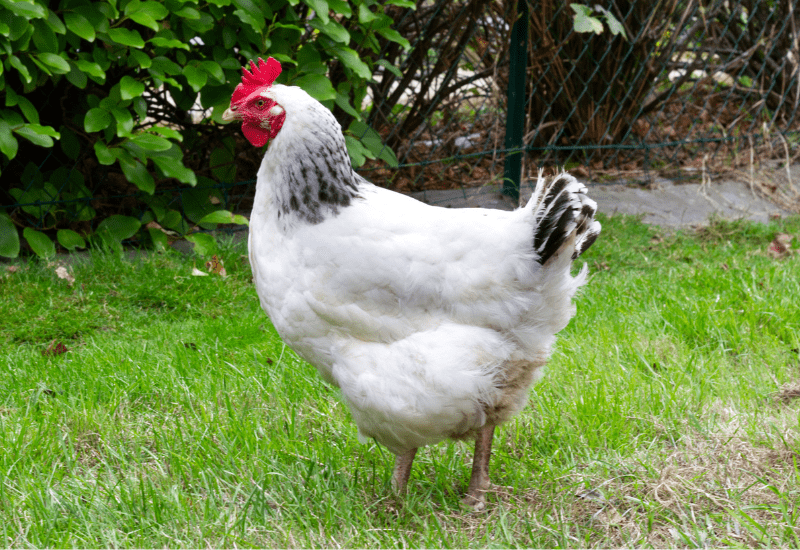
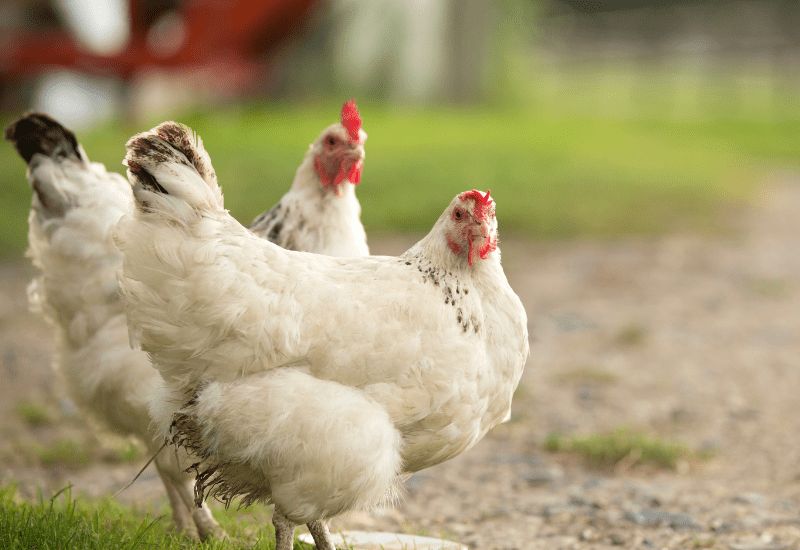
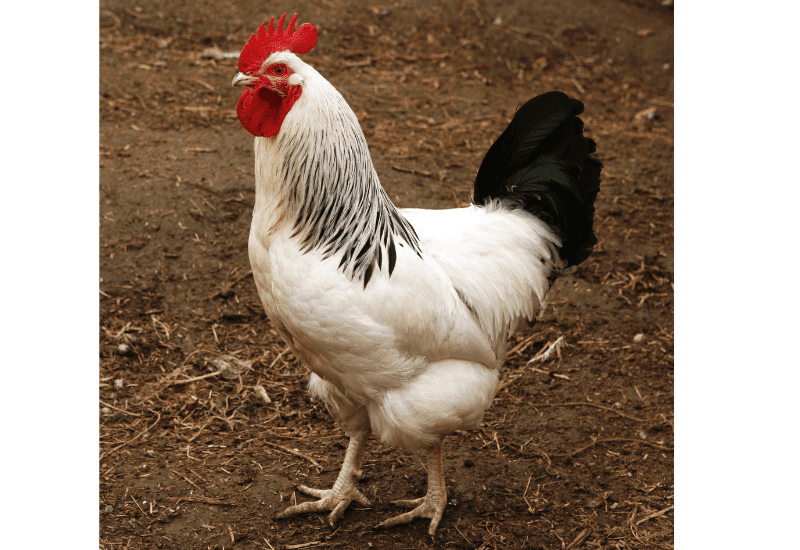
Light Sussex Chickens Are Genetically “Silver”
Light and white Sussex hens are genetically “silver.” As a result, if you cross them with a “gold” rooster, such as a male Rhode Island Red, Buff Orpington, Brown Leghorn, or speckled Sussex, the hybrid offspring will be sex-linked. The male offspring will have plumage characteristics like the mother, and the female offspring will have plumage like the father.
This intriguing phenomenon only works if you mate a “gold” male to a “silver” female. If the reverse crossing is done, all of the offspring will be “silver” in appearance because the silver trait is dominant. While genetically silver chickens are all white or light, not all lightly-colored chickens are genetically silver. However, the light and Light Sussex are.
This phenomenon benefits commercial breeders, as unwanted cockerels do not need to be raised until they show mature secondary sexual characteristics. Instead, they can be identified as day-old chicks and eliminated.
Sex-linked or hybrid chickens tend to be good dual-purpose birds. Still, offspring will not breed true, and any offspring you get by mating them will vary significantly in appearance, temperament, and production characteristics.
Health Issues And Special Requirements Of Light Sussex Chickens
Sussex chickens are generally robust and hardy, able to thrive in various conditions. They do well in warm weather if they have enough shady places to rest and access to cool water. They are one of the most cold-hardy breeds and lay right through the most bitter winters. They do better if allowed to range freely but can be kept cooped up.
They have no particular health issues except a tendency toward obesity. If you are fattening one for the table, you can let it gain as much weight as possible, but for them to keep laying eggs, you will have to ensure that they stay trim.
As with any breed of chicken, you should monitor for internal and external parasites and maintain good basic biosecurity to prevent problems with rodents or infection by deadly diseases such as avian flu and exotic Newcastle disease.
However, Sussex chickens are a low-maintenance breed that does not require any special treatment.
Sussex chicks generally mature fast and will start to lose their fluff at around 1 week old, with the adult plumage growing in by the time they are 1 month old. Speckled Sussex chicks mature somewhat slower than the other varieties.
In adulthood, they are medium to large. Hens should be around 7 pounds and roosters about 9 pounds. Bantams are, of course, smaller, with hens approximately 2 pounds and roosters about 4 pounds. The standard weight for cockerels is 7.5 pounds, and pullets are 6 pounds.
Temperament Of Sussex Chickens
The temperament of Sussex chickens of all varieties can be summed up as companionable, curious, and laidback. These traits make them excellent for beginners and backyard chicken keepers. Let’s examine these traits in more detail.
Light Sussex Chickens Are Companionable
Sussex chickens are gentle and friendly and enjoy the company of their humans. They are docile, and you can pick them up, hold them, and stroke them, which makes them great pets for kids. Children generally love playing with Sussex chickens. As chicks, they are friendly and will trustingly hop onto your lap at a few days old.
They are talkative and often engage in conversation with their people. However, they are not noisy and will murmur rather than squawk. As a result, they are suitable for keeping around neighbors who would be annoyed by louder breeds. The only time Sussex chickens are noisy is if they raise the alarm.
Light Sussex Chickens Are Curious
They are a curious, breed, and as your chicks grow older, they will enjoy exploring your yard. They will follow you if they think you have treats for them, and if you do garden work such as digging, your Sussex chickens will probably join in.
They love to roam around and forage and are pretty good at foraging, although some people have reported that they are reluctant to try new foods. Nevertheless, their foraging capabilities make them thrifty hens, and you will not have to spend too much on feed for them while they convert what they have foraged into eggs (and meat, if you so choose).
Light Sussex Chickens Are Laidback
They are gentle and laidback, with even the roosters being pretty mellow. While their calmness and easygoing nature make them ideal for novice chicken keepers, we recommend caution when keeping them in a mixed flock.
Don’t put them in with more aggressive or pushy chicken breeds, as these will tend to bully the Sussex chickens. Your Sussex hens will end up at the bottom of the pecking order.
Sussex chickens generally require around 4 square feet of space each in the coop. However, if you are putting them in with other, pushier chicken breeds, we recommend increasing the area you give them to 6 square feet each.
Laying Capability Of Light Sussex Chickens
Sussex chickens are moderately good layers, although their exact laying capability varies between varieties. They will generally lay 3 to 4 large cream to pinkish-brown eggs per week, which adds up to somewhere between 180 and 210 eggs per year.
Light and white Sussex chickens are generally better layers, producing up to 5 eggs per week, or 250 eggs per year. On the other hand, exhibition strains tend to be poor layers.
To put their egg-laying capabilities in perspective, they produce roughly the same number of eggs as breeds such as the Plymouth Rock and Orpington. In contrast, commercial egg producers use breeds such as the white Leghorn or hybrids such as the Red Star, Black Star, and Golden Comet. These commercial strains lay 300 eggs per year or more.
However, white Leghorns, in particular, are jittery, noisy, and occasionally aggressive birds and are not recommended for beginners or backyard poultry keepers. If you want more eggs per week, keep a few more hens of a breed that is easy to handle.
One of the significant advantages of Sussex hens as layers is that they lay throughout the year, even in the depths of winter. The only time they don’t lay is when they are molting. They begin laying later than other breeds, around 8 months old and will lay for 2 to 3 years before slowing down.
Sussex hens have a reputation for being broody, but this characteristic makes them good mothers. So if you are planning to keep a rooster and raise chicks, you will find this trait useful. However, the degree of broodiness varies between varieties, with light and light Sussex rarely being broody. How much this is true probably depends on the particular line you buy from.
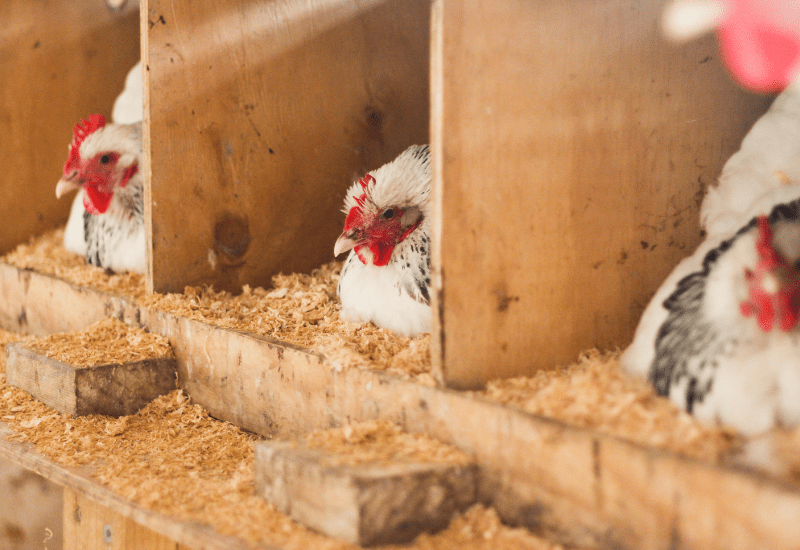
Raising Light Sussex Chickens For Meat
Although you will probably become too attached to your gentle and friendly Sussex chickens to consider eating them, they are a dual-purpose breed and can be fattened for the pot. Their natural tendency to put on weight works to your advantage when doing so.
They have white flesh with superb flavor and were once the premier table bird in England. If you are raising birds to eat, please get someone to show you how to kill them humanely.
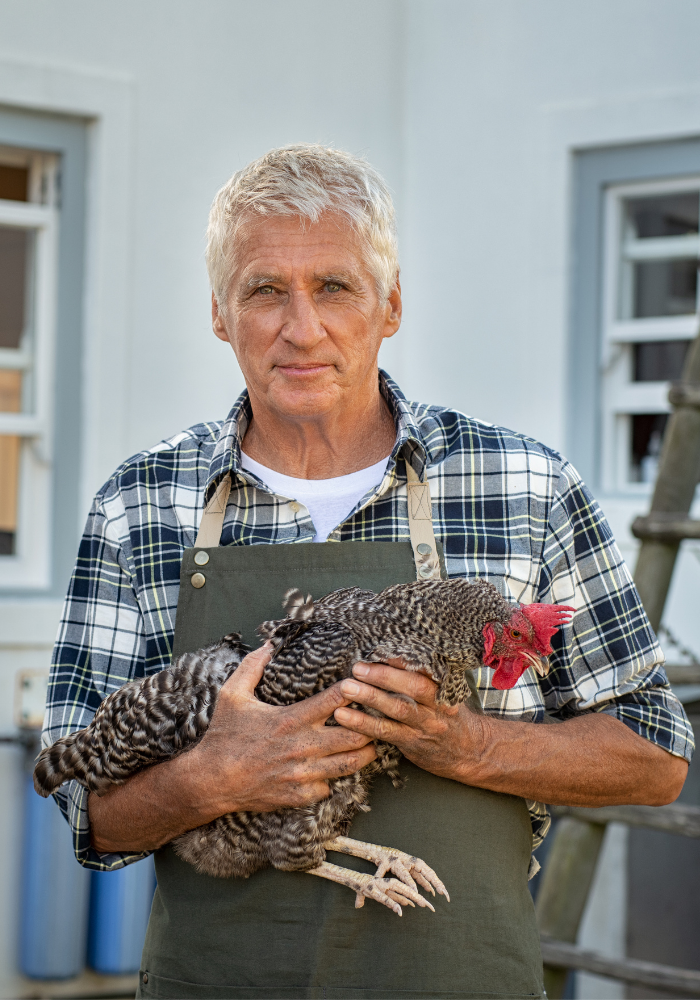
David Cameron is a passionate chicken enthusiast. Growing up, he always wanted to be a veterinarian and loved animals. After graduating from veterinary school, David spent over 40 years as an equine veterinarian. He and his wife retired a few years ago and moved to North Carolina. Here, David’s love of chickens grew even more – he now has 7 chickens and 6 quail. If you have any questions about chickens, feel free to reach out.

